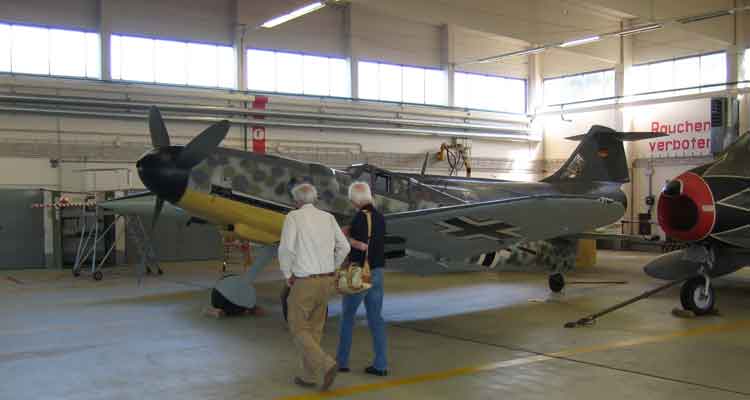
|
|
Visit May 2008 - The group were shown a collection of real aircraft which we were not able to see during our visit in 2006. Maurice Gavan, on the left, and Gunter Kipp examine a Messerschmitt Bf 109. (Does anyone know what exact mark of the Bf109?) (Thanks to Lt Col Joachim Linke.) The development of willi Messerschmitt's famous Bf 109 fighter began in 1933, when the Reichsluftministerium (RLM) issued a requirement for a new monoplane fighter. (The prefix Bf', incidentally, is a company designation denoting Bayerische Flugzeugwerke, the Bavarian Aircraft Factory where the type was first manufactured.) The prototype Bf 109V-1 flew for the first time in September 1935 powered by a 518kW (695hp) Rolls-Royce Kestrel engine, as the 455kW (610hp) Junkers Jumo 210A which was intended for it was not yet available — it was installed in the second prototype, which flew in January 1936. The third aircraft, the Bf 109V-3, was intended to be the prototype for the initial production model, the Bf 109A; however, its armament of only two MG 17 machine guns was rightly considered to be inadequate and was increased in subsequent aircraft. The Bf 109V-7, armed with two machine guns and a single MG FF (20mm/0.79in Oerlikon cannon), consequently became the prototype for the first series production model, the Bf 109B, which was powered by a 455kW (610hp) Jumo 210 engine. One innovation, the Bf 109's narrow-track undercarriage, was designed so that the fuselage rather than the wings bore the weight of the aircraft on the ground; however, five per cent of all 109s built, some 1750 aircraft, were destroyed in landing accidents. Three of the Bf 109 prototypes were evaluated in Spain in February and March 1937, and were followed by 24 Bf 109B-2s, which immediately proved superior to any other fighter engaged in the civil war. It was the use of the Bf 109 in Spain that helped the Luftwaffe to develop the fighter tactics that would wreak havoc among its opponents in the early years of World War II. By the time that conflict began in September 1 1060 Bf 109s of various subspecies were in service with the Luftwaffe's fighter units. These included the Bf 109C and Bf 109D, which were already being replaced by the Bf 109E series; this model was to be the main of the Luftwaffe's fighter units throughout 1940. Ten Bf 109Es were converted for operations from Germany's planned aircraft carrier, the Graf Zeppelin, under the designation Bf 109T. Nineteen Bf 109E-3s were exported to Bulgaria, 40 to Hungary, two to Japan, 69 to Romania, 16 to Slovakia, 80 to Switzerland, five to the USSR and 73 to Yugoslav. The best of all Bf 109 variants, the Bf 109F, began to reach Luftwaffe units in France in May 1941 and was superior in most respects to the principal RAF fighter of the - time, the Spitfire Mk V. The Bf 109F differed from the Bf 109e in having a generally cleaned-up airframe with redesigned engine cowling, wing, radiators and tail assembly. The Bf 109F was succeeded by the Bf 109G, which appeared late in 1942. The last operational versions of the Bf 109 were the K-4 and K-6, which both had DB 605D engines with MW 50 power boost. The last variant was the Bf 109K-14, with a DB-605L engine, but only two examples saw service with JG 52. The Bf 109G was built in both Spain (as the Hispano Ha-1109) and Czechoslovakia (as the Avia S-199). The Spanish aircraft, some re-engined with Rolls-Royce Merlins, served for many years after World War II and some of Czech-built aircraft were acquired by Israel in 1948, equipping No 101 Squadron. In all, Bf 109 production reached a total of approximately 35,000 aircraft Specifications apply to the Bf 109G-6. Crew: 1; Powerplant: one 1,100kW (1,474hp) Daimler-Benz DB 605AM 12-cylinder inverted-Vee engine; Performance: max speed 621km/h (386mph); range 1,000km (620 miles); service ceiling 11,550m (37,890ft); Dimensions: wingspan 9.92m (32ft 6in); length 8.85m (29ft); height 2.50m (8ft 2in); Weight: 3,400kg (7,4961b); loaded Armament: one 20mm (0.79in) or 30mm (1.18in) cannon and two 12.7mm (0.50in) machine guns; external bomb load of 250kg (551 1b). (Thanks to "The Encyclopedia of Aircraft" by Robert Jackson). |